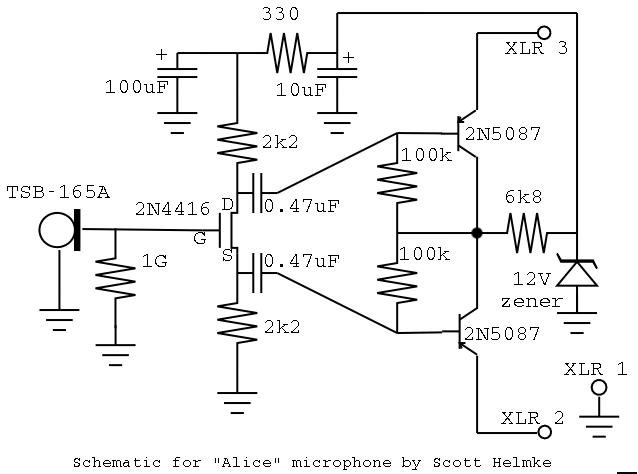midwayfair
Well-known member
I found some old V-Tech dynamics -- they sounded pretty lousy, and I don't see the point in buying a so I picked up a few electret capsules and I've got them running with a Schoeps/Alice circuit squeezed in there.

There's just this nagging little problem of a slide switch on the outside of the mics. Originally it turned the microphone off, but I'd like to do a low-cut instead for close-micing.
There are two places I could see having a low-cut, but I'm not sure which is best. The first is obviously to switch in a capacitor at the input (there's no input cap in the Alice mic), but I'm not really sure what's an effective value there given that the calculator's telling me that with the 1G gate resistor even 10pF is still below 20Hz. I know that the resistance there can't actually be 1G because a FET junction isn't that high, but I don't have a multimeter that could measure the actual impedance accurately to figure out a better number to use.
There's also the pair of 100K resistors forming high-pass filters with the 470nF caps. I was thinking I could switch a resistor in that goes across the two channels. My problem there is that, again, I need what seems like a super low value -- 22K -- to even approach a 20Hz cutoff! That's also losing some raw signal at all frequencies. I could compromise and use 47nF caps and 1M resistors with no change in bass response, then switch in a 100K and ... well, that's still only 34Hz, which is barely a dent in anything except the sound of the central heating.

There's just this nagging little problem of a slide switch on the outside of the mics. Originally it turned the microphone off, but I'd like to do a low-cut instead for close-micing.
There are two places I could see having a low-cut, but I'm not sure which is best. The first is obviously to switch in a capacitor at the input (there's no input cap in the Alice mic), but I'm not really sure what's an effective value there given that the calculator's telling me that with the 1G gate resistor even 10pF is still below 20Hz. I know that the resistance there can't actually be 1G because a FET junction isn't that high, but I don't have a multimeter that could measure the actual impedance accurately to figure out a better number to use.
There's also the pair of 100K resistors forming high-pass filters with the 470nF caps. I was thinking I could switch a resistor in that goes across the two channels. My problem there is that, again, I need what seems like a super low value -- 22K -- to even approach a 20Hz cutoff! That's also losing some raw signal at all frequencies. I could compromise and use 47nF caps and 1M resistors with no change in bass response, then switch in a 100K and ... well, that's still only 34Hz, which is barely a dent in anything except the sound of the central heating.






![Electronics Soldering Iron Kit, [Upgraded] Soldering Iron 110V 90W LCD Digital Portable Soldering Kit 180-480℃(356-896℉), Welding Tool with ON/OFF Switch, Auto-sleep, Thermostatic Design](https://m.media-amazon.com/images/I/41gRDnlyfJS._SL500_.jpg)



























